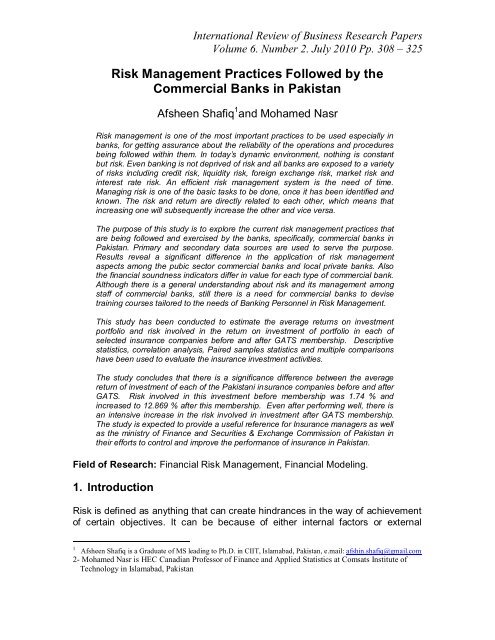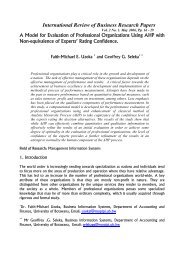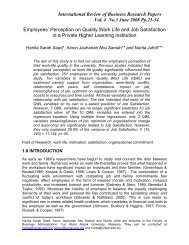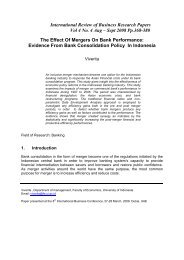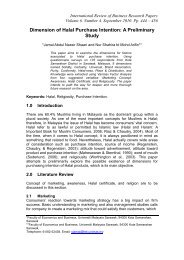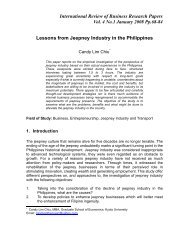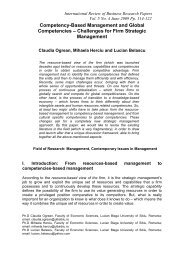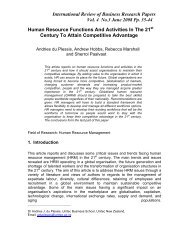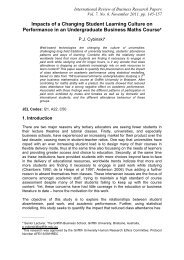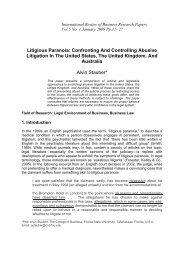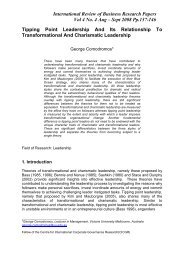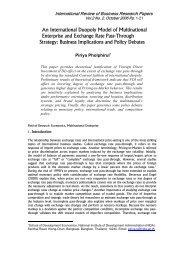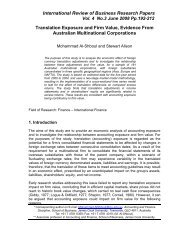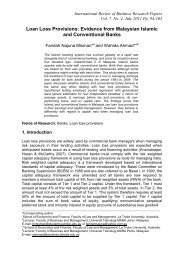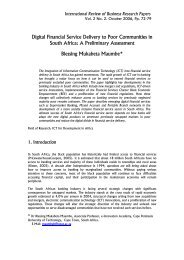Risk Management Practices Followed by the Commercial Banks in ...
Risk Management Practices Followed by the Commercial Banks in ...
Risk Management Practices Followed by the Commercial Banks in ...
You also want an ePaper? Increase the reach of your titles
YUMPU automatically turns print PDFs into web optimized ePapers that Google loves.
International Review of Bus<strong>in</strong>ess Research Papers<br />
Volume 6. Number 2. July 2010 Pp. 308 – 325<br />
<strong>Risk</strong> <strong>Management</strong> <strong>Practices</strong> <strong>Followed</strong> <strong>by</strong> <strong>the</strong><br />
<strong>Commercial</strong> <strong>Banks</strong> <strong>in</strong> Pakistan<br />
Afsheen Shafiq 1 and Mohamed Nasr<br />
<strong>Risk</strong> management is one of <strong>the</strong> most important practices to be used especially <strong>in</strong><br />
banks, for gett<strong>in</strong>g assurance about <strong>the</strong> reliability of <strong>the</strong> operations and procedures<br />
be<strong>in</strong>g followed with<strong>in</strong> <strong>the</strong>m. In today’s dynamic environment, noth<strong>in</strong>g is constant<br />
but risk. Even bank<strong>in</strong>g is not deprived of risk and all banks are exposed to a variety<br />
of risks <strong>in</strong>clud<strong>in</strong>g credit risk, liquidity risk, foreign exchange risk, market risk and<br />
<strong>in</strong>terest rate risk. An efficient risk management system is <strong>the</strong> need of time.<br />
Manag<strong>in</strong>g risk is one of <strong>the</strong> basic tasks to be done, once it has been identified and<br />
known. The risk and return are directly related to each o<strong>the</strong>r, which means that<br />
<strong>in</strong>creas<strong>in</strong>g one will subsequently <strong>in</strong>crease <strong>the</strong> o<strong>the</strong>r and vice versa.<br />
The purpose of this study is to explore <strong>the</strong> current risk management practices that<br />
are be<strong>in</strong>g followed and exercised <strong>by</strong> <strong>the</strong> banks, specifically, commercial banks <strong>in</strong><br />
Pakistan. Primary and secondary data sources are used to serve <strong>the</strong> purpose.<br />
Results reveal a significant difference <strong>in</strong> <strong>the</strong> application of risk management<br />
aspects among <strong>the</strong> pubic sector commercial banks and local private banks. Also<br />
<strong>the</strong> f<strong>in</strong>ancial soundness <strong>in</strong>dicators differ <strong>in</strong> value for each type of commercial bank.<br />
Although <strong>the</strong>re is a general understand<strong>in</strong>g about risk and its management among<br />
staff of commercial banks, still <strong>the</strong>re is a need for commercial banks to devise<br />
tra<strong>in</strong><strong>in</strong>g courses tailored to <strong>the</strong> needs of Bank<strong>in</strong>g Personnel <strong>in</strong> <strong>Risk</strong> <strong>Management</strong>.<br />
This study has been conducted to estimate <strong>the</strong> average returns on <strong>in</strong>vestment<br />
portfolio and risk <strong>in</strong>volved <strong>in</strong> <strong>the</strong> return on <strong>in</strong>vestment of portfolio <strong>in</strong> each of<br />
selected <strong>in</strong>surance companies before and after GATS membership. Descriptive<br />
statistics, correlation analysis, Paired samples statistics and multiple comparisons<br />
have been used to evaluate <strong>the</strong> <strong>in</strong>surance <strong>in</strong>vestment activities.<br />
The study concludes that <strong>the</strong>re is a significance difference between <strong>the</strong> average<br />
return of <strong>in</strong>vestment of each of <strong>the</strong> Pakistani <strong>in</strong>surance companies before and after<br />
GATS. <strong>Risk</strong> <strong>in</strong>volved <strong>in</strong> this <strong>in</strong>vestment before membership was 1.74 % and<br />
<strong>in</strong>creased to 12.869 % after this membership. Even after perform<strong>in</strong>g well, <strong>the</strong>re is<br />
an <strong>in</strong>tensive <strong>in</strong>crease <strong>in</strong> <strong>the</strong> risk <strong>in</strong>volved <strong>in</strong> <strong>in</strong>vestment after GATS membership.<br />
The study is expected to provide a useful reference for Insurance managers as well<br />
as <strong>the</strong> m<strong>in</strong>istry of F<strong>in</strong>ance and Securities & Exchange Commission of Pakistan <strong>in</strong><br />
<strong>the</strong>ir efforts to control and improve <strong>the</strong> performance of <strong>in</strong>surance <strong>in</strong> Pakistan.<br />
Field of Research: F<strong>in</strong>ancial <strong>Risk</strong> <strong>Management</strong>, F<strong>in</strong>ancial Model<strong>in</strong>g.<br />
1. Introduction<br />
<strong>Risk</strong> is def<strong>in</strong>ed as anyth<strong>in</strong>g that can create h<strong>in</strong>drances <strong>in</strong> <strong>the</strong> way of achievement<br />
of certa<strong>in</strong> objectives. It can be because of ei<strong>the</strong>r <strong>in</strong>ternal factors or external<br />
1 Afsheen Shafiq is a Graduate of MS lead<strong>in</strong>g to Ph.D. <strong>in</strong> CIIT, Islamabad, Pakistan, e.mail: afsh<strong>in</strong>.shafiq@gmail.com<br />
2- Mohamed Nasr is HEC Canadian Professor of F<strong>in</strong>ance and Applied Statistics at Comsats Institute of<br />
Technology <strong>in</strong> Islamabad, Pakistan
Shafiq & Nasr<br />
factors, depend<strong>in</strong>g upon <strong>the</strong> type of risk that exists with<strong>in</strong> a particular situation.<br />
Exposure to that risk can make a situation more critical. A better way to deal with<br />
such a situation; is to take certa<strong>in</strong> proactive measures to identify any k<strong>in</strong>d of risk<br />
that can result <strong>in</strong> undesirable outcomes. In simple terms, it can be said that<br />
manag<strong>in</strong>g a risk <strong>in</strong> advance is far better than wait<strong>in</strong>g for its occurrence.<br />
The idea of risk differs from that of probability and uncerta<strong>in</strong>ty. <strong>Risk</strong> is said to be<br />
absent with<strong>in</strong> a situation where a person is 100% certa<strong>in</strong> about <strong>the</strong> outcome. This<br />
idea also brought <strong>the</strong> rise of <strong>in</strong>surance with its orig<strong>in</strong>. Insurance is <strong>the</strong> basis upon<br />
which people show a good deal of will<strong>in</strong>gness to take risk; it creates <strong>the</strong><br />
foundation of <strong>the</strong> security where fortune has been ousted <strong>by</strong> an active<br />
engagement with <strong>the</strong> future. On <strong>the</strong> o<strong>the</strong>r hand, <strong>the</strong> practice of <strong>Risk</strong> <strong>Management</strong><br />
is a measure that is used for identify<strong>in</strong>g, analyz<strong>in</strong>g and <strong>the</strong>n respond<strong>in</strong>g to a<br />
particular risk. It is a process that is cont<strong>in</strong>uous <strong>in</strong> nature and a helpful tool <strong>in</strong><br />
decision mak<strong>in</strong>g process. Accord<strong>in</strong>g to <strong>the</strong> Higher Education Fund<strong>in</strong>g Council for<br />
England (HEFCE), <strong>Risk</strong> <strong>Management</strong> is not just used for ensur<strong>in</strong>g <strong>the</strong> reduction<br />
of <strong>the</strong> probability of bad happen<strong>in</strong>gs but it also covers <strong>the</strong> <strong>in</strong>crease <strong>in</strong> likel<strong>in</strong>ess of<br />
occurr<strong>in</strong>g good th<strong>in</strong>gs. A model called “Prospect Theory” states that a person is<br />
more likely to take on <strong>the</strong> risk than to suffer a sure loss.<br />
<strong>Risk</strong> exists as a part of an environment <strong>in</strong> which various organizations operate<br />
(Tchankova, 2002). Bank<strong>in</strong>g is a bus<strong>in</strong>ess mostly associated with risk because of<br />
its large exposure to uncerta<strong>in</strong>ty and huge considerations. <strong>Risk</strong> management is<br />
one of <strong>the</strong> most important practices to be used especially <strong>in</strong> banks, for gett<strong>in</strong>g<br />
assurance about <strong>the</strong> reliability of <strong>the</strong> operations and procedures be<strong>in</strong>g followed.<br />
In today’s dynamic environment, all banks are exposed to a large number of risks<br />
such as credit risk, liquidity risk, foreign exchange risk, market risk and <strong>in</strong>terest<br />
rate risk, among o<strong>the</strong>rs – <strong>the</strong> risks which may create some source of threat far a<br />
bank's survival and success (Al-Tamimi and Al-Mazrooei, 2007).<br />
Due to such exposure to various risks, efficient risk management is required.<br />
Manag<strong>in</strong>g risk is one of <strong>the</strong> basic tasks to be done, once it has been identified<br />
and known. The risk and return are directly related to each o<strong>the</strong>r, which means<br />
that <strong>in</strong>creas<strong>in</strong>g one will subsequently <strong>in</strong>crease <strong>the</strong> o<strong>the</strong>r and vice versa. And,<br />
effective risk management leads to more balanced trade-off between risk and<br />
reward, to realize a better position <strong>in</strong> <strong>the</strong> future (Fatemi and Fooladi, 2006).<br />
It is also realized recently that <strong>Risk</strong> <strong>Management</strong> is essentially more important to<br />
be carried upon <strong>in</strong> <strong>the</strong> f<strong>in</strong>ancial sector than any o<strong>the</strong>r part of <strong>the</strong> economy. It<br />
makes more sense when it is known that <strong>the</strong> ma<strong>in</strong> purpose of <strong>the</strong> f<strong>in</strong>ancial<br />
<strong>in</strong>stitutions is to maximize revenues and offer <strong>the</strong> maximum value to <strong>the</strong><br />
shareholders <strong>by</strong> facilitat<strong>in</strong>g <strong>the</strong>m with a variety of f<strong>in</strong>ancial services especially <strong>by</strong><br />
adm<strong>in</strong>ister<strong>in</strong>g risks (Al-Tamimi and Al-Mazrooei, 2007). The prime reason to<br />
adopt risk management practices is to avoid <strong>the</strong> probable failure <strong>in</strong> future. But, <strong>in</strong><br />
realistic terms, risk management is clearly not free of cost. In fact, it is expensive<br />
<strong>in</strong> both resources and <strong>in</strong> <strong>in</strong>stitutional disruption. But <strong>the</strong> cost of delay<strong>in</strong>g or<br />
309
Shafiq & Nasr<br />
avoid<strong>in</strong>g proper risk management can lead to some adverse results, like failure of<br />
a bank and possibly failure of a bank<strong>in</strong>g system (Meyer, 2000).<br />
The bank<strong>in</strong>g <strong>in</strong>dustry recognizes that an <strong>in</strong>stitution needs not do bus<strong>in</strong>ess <strong>in</strong> a<br />
manner that unnecessarily imposes risk upon it; nor should it absorb risk that can<br />
be efficiently transferred to o<strong>the</strong>r participants. Ra<strong>the</strong>r, it should only manage risks<br />
at <strong>the</strong> firm level that are more efficiently managed <strong>the</strong>re than <strong>by</strong> <strong>the</strong> market itself<br />
or <strong>by</strong> <strong>the</strong>ir owners <strong>in</strong> <strong>the</strong>ir own portfolios. In short, it should accept only those<br />
risks that are uniquely a part of <strong>the</strong> bank's array of services.<br />
Bank<strong>in</strong>g is one of <strong>the</strong> most sensitive bus<strong>in</strong>esses <strong>in</strong> any economy s<strong>in</strong>ce it acts as<br />
a life-blood of modern trade and commerce to provide <strong>the</strong>m with <strong>the</strong> major<br />
sources of f<strong>in</strong>ance. Pakistan is one of <strong>the</strong> key emerg<strong>in</strong>g markets of South Asia<br />
and its bank<strong>in</strong>g sector consists of <strong>Commercial</strong> <strong>Banks</strong> and Specialized Bank<strong>in</strong>g<br />
Institutions, regulated <strong>by</strong> <strong>the</strong> State Bank of Pakistan. Pakistan is one of few<br />
develop<strong>in</strong>g countries, where <strong>the</strong> public sector banks were privatized with<strong>in</strong> a<br />
limited time span. The Federal Government is now left with only <strong>the</strong> National<br />
Bank and First Women Bank, while <strong>the</strong> State Prov<strong>in</strong>ce owned banks are <strong>the</strong><br />
Bank of Khyber and Bank of Punjab. The Bank<strong>in</strong>g Sector has significantly<br />
improved its performance dur<strong>in</strong>g <strong>the</strong> last few years as more foreign banks have<br />
also started <strong>the</strong>ir operations <strong>in</strong> this region.<br />
The time period between “2002-2007” proved to be of significant growth for <strong>the</strong><br />
bank<strong>in</strong>g sector of Pakistan. Classified as Pakistan’s and region’s best perform<strong>in</strong>g<br />
sector, <strong>the</strong> bank<strong>in</strong>g <strong>in</strong>dustry’s assets <strong>in</strong>creased over $60 billion, its profitability<br />
rema<strong>in</strong>s high, non-perform<strong>in</strong>g loans (NPLs) are low, credit is fairly diversified and<br />
bank-wide system risks are well-conta<strong>in</strong>ed. Almost 81% of bank<strong>in</strong>g assets are <strong>in</strong><br />
private hands. It shows that privatization of <strong>the</strong> major portion of <strong>the</strong> banks has<br />
<strong>in</strong>creased competition among <strong>the</strong>m and resulted <strong>in</strong> <strong>the</strong> cont<strong>in</strong>uous <strong>in</strong>crease <strong>in</strong><br />
performance to reta<strong>in</strong> <strong>the</strong>ir customers through efficient means. Currently, it is<br />
more obvious that <strong>in</strong>creased competition <strong>in</strong> consumer bank<strong>in</strong>g has <strong>in</strong>creased <strong>the</strong><br />
need for effective and efficient risk management for <strong>the</strong> banks to ga<strong>in</strong> a<br />
competitive edge.<br />
The risk arises from uncerta<strong>in</strong>ty of a particular situation and certa<strong>in</strong>ty of be<strong>in</strong>g<br />
exposed to that situation. <strong>Risk</strong> <strong>Management</strong> as commonly perceived does not<br />
mean to m<strong>in</strong>imize risk; <strong>in</strong> fact, its goal is to optimize <strong>the</strong> risk-reward trade off.<br />
And, <strong>the</strong> role of risk management is to assure that an <strong>in</strong>stitution does not have<br />
any need to engage <strong>in</strong> a bus<strong>in</strong>ess that unnecessarily imposes risk upon it. Also, it<br />
should not absorb any such risks that have <strong>the</strong> tendency to be transferred to<br />
o<strong>the</strong>r participants. Ra<strong>the</strong>r it should only accept those risks that are uniquely a<br />
part of <strong>the</strong> array of bank’s services. In this regard, risk management aspects<br />
such as Understand<strong>in</strong>g risk and risk management, risk identification, risk<br />
assessment and analysis, risk monitor<strong>in</strong>g, risk management practices and credit<br />
risk analysis of <strong>the</strong> banks have to be considered for assess<strong>in</strong>g <strong>the</strong>ir risk<br />
management approach.<br />
310
2. Literature Review<br />
Shafiq & Nasr<br />
With<strong>in</strong> <strong>the</strong> last few years, a number of studies have provided <strong>the</strong> discipl<strong>in</strong>e <strong>in</strong>to<br />
<strong>the</strong> practice of risk management with<strong>in</strong> <strong>the</strong> corporate and bank<strong>in</strong>g sector. An<br />
<strong>in</strong>sight of related studies is as follows:<br />
Amran, et al. (2009), explored <strong>the</strong> availability of risk disclosures <strong>in</strong> <strong>the</strong> annual<br />
reports of Malaysian companies. The study was aimed to empirically test <strong>the</strong><br />
characteristics of <strong>the</strong> sampled companies. The level of risk faced <strong>by</strong> <strong>the</strong>se<br />
companies with <strong>the</strong> disclosure made was also assessed and compared. The<br />
f<strong>in</strong>d<strong>in</strong>gs of <strong>the</strong> research revealed that <strong>the</strong> strategic risk came on <strong>the</strong> top, followed<br />
<strong>by</strong> <strong>the</strong> operations and empowerment risks be<strong>in</strong>g disclosed <strong>by</strong> <strong>the</strong> selected<br />
companies. The regression analysis proved significantly that size of <strong>the</strong><br />
companies did matter. The stakeholder <strong>the</strong>ory expla<strong>in</strong>s well this f<strong>in</strong>d<strong>in</strong>g <strong>by</strong> stat<strong>in</strong>g<br />
that “As company grows bigger, it will have a large pool of stakeholders, who<br />
would be <strong>in</strong>terested <strong>in</strong> know<strong>in</strong>g <strong>the</strong> affairs of <strong>the</strong> company.” The extent of risk<br />
disclosure was also found to be <strong>in</strong>fluenced <strong>by</strong> <strong>the</strong> nature of <strong>in</strong>dustry. As explored<br />
with<strong>in</strong> this study, <strong>in</strong>frastructure and technology <strong>in</strong>dustries <strong>in</strong>fluenced <strong>the</strong><br />
companies to have more risk <strong>in</strong>formation disclosed.<br />
Hassan, A. (2009), made a study “<strong>Risk</strong> <strong>Management</strong> <strong>Practices</strong> of Islamic <strong>Banks</strong><br />
of Brunei Darussalam” to assess <strong>the</strong> degree to which <strong>the</strong> Islamic banks <strong>in</strong> Brunei<br />
Darussalam implemented risk management practices and carried <strong>the</strong>m out<br />
thoroughly <strong>by</strong> us<strong>in</strong>g different techniques to deal with various k<strong>in</strong>ds of risks. The<br />
results of <strong>the</strong> study showed that, like <strong>the</strong> conventional bank<strong>in</strong>g system, Islamic<br />
bank<strong>in</strong>g was also subjected to a variety of risks due to <strong>the</strong> unique range of<br />
offered products <strong>in</strong> addition to conventional products. The results showed that<br />
<strong>the</strong>re was a remarkable understand<strong>in</strong>g of risk and risk management <strong>by</strong> <strong>the</strong> staff<br />
work<strong>in</strong>g <strong>in</strong> <strong>the</strong> Islamic <strong>Banks</strong> of Brunei Darussalam, which showed <strong>the</strong>ir ability to<br />
pave <strong>the</strong>ir way towards successful risk management. The major risks that were<br />
faced <strong>by</strong> <strong>the</strong>se banks were Foreign exchange risk, credit risk and operat<strong>in</strong>g risk.<br />
A regression model was used to elaborate <strong>the</strong> results which showed that <strong>Risk</strong><br />
Identification, and <strong>Risk</strong> Assessment and Analysis were <strong>the</strong> most <strong>in</strong>fluenc<strong>in</strong>g<br />
variables and <strong>the</strong> Islamic banks <strong>in</strong> Brunei needed to give more attention to those<br />
variables to make <strong>the</strong>ir <strong>Risk</strong> <strong>Management</strong> <strong>Practices</strong> more effective <strong>by</strong><br />
understand<strong>in</strong>g <strong>the</strong> true application of Basel-II Accord to improve <strong>the</strong> efficiency of<br />
Islamic Bank’s risk management systems.<br />
Al-Tamimi (2008) studied <strong>the</strong> relationship among <strong>the</strong> read<strong>in</strong>ess of implement<strong>in</strong>g<br />
Basel II Accord and resources needed for its implementation <strong>in</strong> UAE banks.<br />
Results of <strong>the</strong> research revealed that <strong>the</strong> banks <strong>in</strong> UAE were aware of <strong>the</strong><br />
benefits, impact and challenges associated <strong>in</strong> <strong>the</strong> implementation of Basel II<br />
Accord. However, <strong>the</strong> research did not confirm any positive relationship between<br />
UAE banks read<strong>in</strong>ess for <strong>the</strong> implementation of Basel II and impact of <strong>the</strong><br />
implementation. The relationship between read<strong>in</strong>ess and anticipated cost of<br />
implementation was also not confirmed. No significant difference was found <strong>in</strong><br />
311
Shafiq & Nasr<br />
<strong>the</strong> level of Basel II Accord’s preparation between <strong>the</strong> UAE national and foreign<br />
banks. It was concluded that <strong>the</strong>re was a significant difference <strong>in</strong> <strong>the</strong> level of <strong>the</strong><br />
UAE banks Basel II based on employees education level. The results supported<br />
<strong>the</strong> importance of education level needed for <strong>the</strong> implementation of Basel II<br />
Accord.<br />
Al-Tamimi and Al- Mazrooei (2007) provided a comparative study of Bank’s <strong>Risk</strong><br />
<strong>Management</strong> of UAE National and Foreign <strong>Banks</strong>. This research helped <strong>the</strong>m to<br />
f<strong>in</strong>d that <strong>the</strong> three most important types of risks fac<strong>in</strong>g <strong>the</strong> UAE commercial<br />
banks were foreign exchange risk, followed <strong>by</strong> credit risk and <strong>the</strong>n operat<strong>in</strong>g risk.<br />
They found that <strong>the</strong> UAE banks were somewhat efficient <strong>in</strong> manag<strong>in</strong>g risk;<br />
however <strong>the</strong> variables such as risk identification, assessment and analysis<br />
proved to be more <strong>in</strong>fluenc<strong>in</strong>g <strong>in</strong> risk management process. F<strong>in</strong>ally, <strong>the</strong> results<br />
<strong>in</strong>dicated that <strong>the</strong>re was a significant difference between <strong>the</strong> UAE National and<br />
Foreign banks <strong>in</strong> practic<strong>in</strong>g risk assessment and analysis, and <strong>in</strong> risk monitor<strong>in</strong>g<br />
and controll<strong>in</strong>g.<br />
Koziol and Lawrenz (2008) provided a study <strong>in</strong> which <strong>the</strong>y assessed <strong>the</strong> risk of<br />
bank failures. They said that assess<strong>in</strong>g <strong>the</strong> risk related to bank failures is <strong>the</strong><br />
paramount concern of bank regulations. They argued that <strong>in</strong> order to assess <strong>the</strong><br />
default risk of a bank, it is important consider<strong>in</strong>g its f<strong>in</strong>anc<strong>in</strong>g decisions as an<br />
endogenous dynamic process. The research study provided a cont<strong>in</strong>uous-time<br />
model, where banks chose <strong>the</strong> deposit volume <strong>in</strong> order to trade off <strong>the</strong> benefits of<br />
earn<strong>in</strong>g deposit premiums aga<strong>in</strong>st <strong>the</strong> costs that would occur at future capital<br />
structure adjustments. Major f<strong>in</strong>d<strong>in</strong>gs suggested that <strong>the</strong> dynamic endogenous<br />
f<strong>in</strong>anc<strong>in</strong>g decision <strong>in</strong>troduced an important self-regulation mechanism.<br />
3. Research Methodology and Design<br />
This study aims to <strong>in</strong>vestigate <strong>the</strong> awareness about risk management practices<br />
with<strong>in</strong> <strong>the</strong> bank<strong>in</strong>g sector of Pakistan. This study is comprised of data collected<br />
through both, primary as well as secondary sources. The purpose of us<strong>in</strong>g<br />
primary source data is to check <strong>the</strong> extent to which different risk management<br />
practices have been followed <strong>by</strong> <strong>the</strong> commercial banks <strong>in</strong> Pakistan. Primary data<br />
is collected through <strong>the</strong> use of a questionnaire. The questionnaire comprises a<br />
number of statements under one macro-statement (variable). The questionnaire<br />
is comparable to one provided <strong>in</strong> a study <strong>by</strong> Al-Tamimi and Al-Mazrooei (2007). It<br />
<strong>in</strong>cludes <strong>Risk</strong> <strong>Management</strong> <strong>Practices</strong> (RMP) as <strong>the</strong> dependent variable, and<br />
different aspects of risk management as <strong>the</strong> <strong>in</strong>dependent or explanatory<br />
variables. Whereas, <strong>the</strong> objective to use secondary data is to l<strong>in</strong>k <strong>the</strong> risk<br />
weighted Capital Adequacy Ratio (CAR) to <strong>the</strong> different f<strong>in</strong>ancial <strong>in</strong>dicators of <strong>the</strong><br />
commercial banks that are used to measure <strong>the</strong>ir soundness.<br />
312
3.1 Study Sample<br />
Shafiq & Nasr<br />
Out of <strong>the</strong> total 36 of commercial banks <strong>in</strong> Pakistan 15 commercial banks were<br />
approached; however, <strong>the</strong> commercial banks that responded timely and<br />
positively were 12 <strong>in</strong> total. A total of 7 questionnaires were distributed <strong>in</strong> each of<br />
<strong>the</strong> bank approached to be filled <strong>by</strong> <strong>the</strong> staff work<strong>in</strong>g specifically <strong>in</strong> <strong>the</strong> <strong>Risk</strong><br />
<strong>Management</strong> department. After <strong>the</strong> elim<strong>in</strong>ation of <strong>the</strong> erroneous responses <strong>the</strong><br />
effective response rate obta<strong>in</strong>ed was around 58% of <strong>the</strong> total sample. An attempt<br />
is made to collect data from each of <strong>the</strong> sampled commercial bank’s risk<br />
management department <strong>in</strong> <strong>the</strong> major cities of Pakistan <strong>in</strong>clud<strong>in</strong>g Islamabad,<br />
Rawalp<strong>in</strong>di, Lahore and Karachi.<br />
The secondary data is collected and assembled from <strong>the</strong> different quarterly<br />
reports on “performance review of <strong>the</strong> bank<strong>in</strong>g system. The available data covers<br />
a period of total 9 years from 2000-2008. The data is ma<strong>in</strong>ly related to <strong>the</strong> <strong>Risk</strong><br />
Weighted Capital Adequacy Ratio (RWCAR) and its impact on different f<strong>in</strong>ancial<br />
<strong>in</strong>dicators of <strong>the</strong> commercial banks that are used to measure <strong>the</strong>ir soundness.<br />
The data ma<strong>in</strong>ly related to <strong>the</strong> commercial banks <strong>in</strong> Pakistan is decomposed <strong>in</strong>to<br />
three ma<strong>in</strong> categories: Public sector commercial banks, local private banks and<br />
foreign banks.<br />
3.2 Variables<br />
This study is ma<strong>in</strong>ly related to <strong>the</strong> risk management practices be<strong>in</strong>g followed <strong>by</strong><br />
<strong>the</strong> commercial <strong>Banks</strong> <strong>in</strong> Pakistan. The questionnaire is used as a ma<strong>in</strong> tool to<br />
collect primary data and check <strong>the</strong> extent to which <strong>the</strong> risk management<br />
practices are be<strong>in</strong>g carried upon <strong>by</strong> <strong>the</strong> commercial banks <strong>in</strong> Pakistan. The six<br />
important aspects of risk management process are categorized as one<br />
dependent and five explanatory variables.<br />
Dependent Variable: The dependent variable of this study is risk management. It<br />
is measured with <strong>the</strong> help of risk management practices and specifically <strong>the</strong>ir<br />
degree of usage with<strong>in</strong> <strong>the</strong> commercial banks of Pakistan.<br />
Independent or Explanatory Variables: The explanatory variables <strong>in</strong>clude <strong>the</strong> five<br />
ma<strong>in</strong> aspects of risk management. These variables are as follows:<br />
Understand<strong>in</strong>g <strong>Risk</strong> and <strong>Risk</strong> <strong>Management</strong>.<br />
<strong>Risk</strong> Identification<br />
<strong>Risk</strong> Assessment and Analysis<br />
<strong>Risk</strong> Monitor<strong>in</strong>g<br />
Credit <strong>Risk</strong> Analysis<br />
3.3 F<strong>in</strong>ancial Soundness Indicators: The secondary data is comprised of four<br />
ma<strong>in</strong> f<strong>in</strong>ancial soundness <strong>in</strong>dicators, each of which is evaluated through a<br />
number of sub-<strong>in</strong>dicators are to aimed to evaluate <strong>the</strong> performance of <strong>the</strong> banks<br />
with<strong>in</strong> a span of a year. Their division is shown as follows:<br />
i. Capital Adequacy Ratio<br />
313
ii. Asset Quality<br />
iii. Earn<strong>in</strong>g<br />
iv. Liquidity<br />
3.4 Hypo<strong>the</strong>sis Test<strong>in</strong>g<br />
Shafiq & Nasr<br />
Based on <strong>the</strong> research questions and problem of <strong>the</strong> study, a set of hypo<strong>the</strong>ses<br />
are developed and tested to show <strong>the</strong> degree of relationships between risk<br />
management practices and each of <strong>the</strong> five aspects of risk management process.<br />
Each of <strong>the</strong> alternative hypo<strong>the</strong>ses formulated is stated below:<br />
H11 There is a positive relationship between risk management practices and<br />
understand<strong>in</strong>g risk and risk management, risk identification, risk assessment and<br />
analysis, risk monitor<strong>in</strong>g and credit risk analysis.<br />
H21 There are significant differences between Pakistan’s public sector and private<br />
local banks <strong>in</strong> <strong>the</strong> use of understand<strong>in</strong>g risk and risk management, risk<br />
identification, risk assessment and analysis, risk monitor<strong>in</strong>g and controll<strong>in</strong>g, risk<br />
management practices and credit risk analysis.<br />
Based on <strong>the</strong> secondary data, <strong>the</strong> follow<strong>in</strong>g alternative hypo<strong>the</strong>sis is formulated<br />
to check <strong>the</strong> difference between <strong>the</strong> values of all <strong>the</strong> f<strong>in</strong>ancial soundness<br />
<strong>in</strong>dicators among <strong>the</strong> three separate groups of commercial banks <strong>in</strong> Pakistan.<br />
H31 There is significant difference between <strong>the</strong> f<strong>in</strong>ancial soundness <strong>in</strong>dicator’s<br />
values between Pakistan’s public sector, local private and foreign banks for all of<br />
<strong>the</strong> n<strong>in</strong>e years rang<strong>in</strong>g from 2000-2008.<br />
3.5 Data Analysis Methods<br />
A regression model is applied to estimate <strong>the</strong> relationship between one<br />
dependent variable and <strong>the</strong> five explanatory variables. The model is as follows:<br />
RMP = ƒ (URM, RI, RAA, RM, CRA)<br />
Where:<br />
RMP = <strong>Risk</strong> <strong>Management</strong> <strong>Practices</strong>;<br />
URM = Understand<strong>in</strong>g <strong>Risk</strong> and <strong>Risk</strong> <strong>Management</strong>;<br />
RI = <strong>Risk</strong> Identification;<br />
RAA = <strong>Risk</strong> Assessment and Analysis;<br />
RM = <strong>Risk</strong> Monitor<strong>in</strong>g; and<br />
CRA = Credit <strong>Risk</strong> Analysis<br />
This model is adopted to test <strong>the</strong> second hypo<strong>the</strong>sis of <strong>the</strong> study. For <strong>the</strong><br />
purpose of test<strong>in</strong>g rest of <strong>the</strong> hypo<strong>the</strong>ses developed specifically for analyz<strong>in</strong>g <strong>the</strong><br />
primary data, ANOVA test is run. Its purpose is to check <strong>the</strong> differences among<br />
various Pakistan’s public sector and local private banks <strong>in</strong> use of all <strong>the</strong> six major<br />
314
Shafiq & Nasr<br />
aspects of <strong>the</strong> <strong>Risk</strong> <strong>Management</strong> Process. Ano<strong>the</strong>r tool used to determ<strong>in</strong>e<br />
whe<strong>the</strong>r a l<strong>in</strong>ear relationship exists between <strong>the</strong> variables is Product Moment<br />
Correlation, r. For <strong>the</strong> purpose of test<strong>in</strong>g <strong>the</strong> secondary data analytically, Analysis<br />
of Variance test is used for each of <strong>the</strong> major f<strong>in</strong>ancial soundness <strong>in</strong>dicator<br />
separately.<br />
4. Data Analysis<br />
4.1 Primary Data Analysis<br />
The reliability of <strong>the</strong> scales used with<strong>in</strong> <strong>the</strong> questionnaire is evaluated us<strong>in</strong>g<br />
Cronbach’s alpha. It allows measur<strong>in</strong>g <strong>the</strong> reliability of different variables. The<br />
questionnaire adopted for this study conta<strong>in</strong>s 43 statements represent<strong>in</strong>g each of<br />
<strong>the</strong> six aspects of risk management. It is used to estimate how much variation <strong>in</strong><br />
scores of different variables is attributable to chance or random errors (Selltiz et<br />
al., 1976). There is a general rule that a coefficient greater than or equal to 0.7 is<br />
considered acceptable and a good <strong>in</strong>dication of construct reliability (Nunnally,<br />
1978). The overall Cronbach’s alpha ( , for <strong>the</strong> six aspects of risk management<br />
process is 0.771 as shown below <strong>in</strong> table 4.1. It means that <strong>the</strong>re is an<br />
acceptable degree of consistency among <strong>the</strong> responses aga<strong>in</strong>st each item.<br />
Table 4.1: Overall Reliability Statistics for six Aspects of Questionnaire<br />
Cronbach's N of<br />
Alpha Items<br />
.771 6<br />
Multiple-Regression Model:<br />
The regression model is applied to estimate <strong>the</strong> relationship between <strong>Risk</strong><br />
<strong>Management</strong> <strong>Practices</strong> and <strong>the</strong> five explanatory variables as follows:<br />
RMP = ƒ (URM, RI, RAA, RM, CRA)<br />
Product moment correlation is used to analyze correlations among <strong>the</strong><br />
explanatory variables, namely understand<strong>in</strong>g risk and risk management (URM),<br />
risk identification (RI), risk assessment and analysis (RAA), risk monitor<strong>in</strong>g (RM),<br />
and credit risk analysis (CRA). Table 4.2 reveals <strong>the</strong> correlation coefficients<br />
between all <strong>the</strong> variables.<br />
This table of bi-correlations is useful to detect any potential case of<br />
multicoll<strong>in</strong>earity. An exam<strong>in</strong>ation of <strong>the</strong> results of correlations presented <strong>in</strong> Table<br />
4.2 shown below suggests that <strong>the</strong>re is no problem of multicoll<strong>in</strong>earity among all<br />
explanatory variables.<br />
315
Shafiq & Nasr<br />
Table 4.2: Correlation Coefficients between Explanatory Variables<br />
RMP<br />
URM<br />
RI<br />
RAA<br />
RM<br />
Pearson<br />
Correlatio<br />
n<br />
Sig. (2-<br />
tailed)<br />
Pearson<br />
Correlatio<br />
n<br />
Sig. (2-<br />
tailed)<br />
Pearson<br />
Correlatio<br />
n<br />
Sig. (2-<br />
tailed)<br />
Pearson<br />
Correlatio<br />
n<br />
Sig. (2-<br />
tailed)<br />
Pearson<br />
Correlatio<br />
n<br />
Sig. (2-<br />
tailed)<br />
RMP URM RI RAA RM CRA<br />
1<br />
.<br />
.269 1<br />
.062 .<br />
.361(*) .439(**) 1<br />
.011 .002 .<br />
.322(*) .403(**) .184 1<br />
.024 .004 .207 .<br />
.305(*) .575(**) .413(**) .470(**) 1<br />
.033 .000 .003 .001 .<br />
Pearson<br />
Correlatio .249 -.015 .255 .253 -.089 1<br />
CRA n<br />
Sig. (2tailed)<br />
.084 .919 .077 .079 .541 .<br />
Notes: * Correlation is significant at <strong>the</strong> 0.05 level (2-tailed).<br />
** Correlation is significant at <strong>the</strong> 0.01 level (2-tailed).<br />
Table 4.3 below shows <strong>the</strong> regression results. It can be seen from <strong>the</strong> results<br />
provided <strong>in</strong> Table 4.3 that R 2 is 0.351. This <strong>in</strong>dicates that <strong>the</strong> five explanatory<br />
variables expla<strong>in</strong> 35.1 percent of <strong>the</strong> variations <strong>in</strong> risk management practices.<br />
316
1%<br />
Shafiq & Nasr<br />
Table 4.3: Model Summary for all explanatory variables<br />
Model R R 2 Adjuste<br />
d R 2 F Sig<br />
1 .592(a) .351 .275 4.645* 0.002*<br />
Predictors: (Constant), CRA, URM, RI, RAA, RM * significant at =<br />
The estimated coefficients of all <strong>the</strong> explanatory variables are <strong>in</strong>significant but<br />
still show a positive impact on risk management practices except URM that is<br />
slightly negatively correlated with RMP. These results obta<strong>in</strong>ed us<strong>in</strong>g <strong>the</strong> study<br />
multiple-regression model is displayed <strong>in</strong> Table 4.4.:<br />
Table 4.4: OLS Regression Result for all Explanatory Variables<br />
Coefficients (a)<br />
4.2 L<strong>in</strong>ear Regression Model<br />
Beta<br />
t<br />
Sig.<br />
(Constant)<br />
URM<br />
1.293<br />
-.004<br />
1.164<br />
-.023<br />
.251<br />
.982<br />
RI .158 1.219 .230<br />
RAA .213 1.259 .215<br />
RM<br />
CRA<br />
.265<br />
.151<br />
1.794*<br />
1.000<br />
.080*<br />
.323<br />
a. Dependent Variable: RMP * Significant at = 10%<br />
S<strong>in</strong>ce <strong>the</strong> results shown on table 4.2 reflect mild multicoll<strong>in</strong>earity, each of <strong>the</strong><br />
explanatory variable is regressed alone to check its impact on RMP. All <strong>the</strong><br />
results are summarized <strong>in</strong> two tables, one of which shows <strong>the</strong> Model summary<br />
for check<strong>in</strong>g <strong>the</strong> impact of each of <strong>the</strong> explanatory variables upon RMP. The first<br />
explanatory variable is URM and it shows that <strong>the</strong> value for R 2 is .097, which<br />
means that URM expla<strong>in</strong>s only 9.7 percent of <strong>the</strong> variation <strong>in</strong> risk management<br />
practices.<br />
317
Shafiq & Nasr<br />
Table 4.5: Model Summary of L<strong>in</strong>ear Regression for all Independent or<br />
Explanatory Variables<br />
Model R R 2<br />
Adjusted R 2<br />
F Sig<br />
URM .312(a) .097 .078 5.071* 0.029**<br />
RI .395(a) .156 .138 8.699* 0.005*<br />
RAA .451(a) .204 .187 12.016* 0.001*<br />
RM .511(a) .261 .245 16.567* 0.000*<br />
CRA .297(a) .088 .069 4.533* 0.039**<br />
a. Predictors: (Constant), URM, RI, RAA, RM, CRA * Significant at = 1% **<br />
Significant at = 5%<br />
The second explanatory variable whose impact is checked <strong>in</strong> relation to RMP is<br />
RI. Table 4.5 shows that <strong>the</strong> value for R 2 is .156, which means that RI expla<strong>in</strong>s<br />
15.6 percent variations <strong>in</strong> <strong>the</strong> risk management practices. Similarly <strong>the</strong> model<br />
summary for RAA shows that <strong>the</strong> value for R 2 is .204, which means that RAA<br />
expla<strong>in</strong>s 20.4 percent variations <strong>in</strong> <strong>the</strong> risk management practices. Likewise, <strong>the</strong><br />
values depicted <strong>in</strong> <strong>the</strong> table 4.5 for R 2 , for RM and CRA are .261 and .088<br />
respectively and thus expla<strong>in</strong> 26.1 percent and 8.8 percent of <strong>the</strong> risk<br />
management practices respectively.<br />
The table 4.6 below depicts <strong>the</strong> <strong>in</strong>dividual estimated coefficient of l<strong>in</strong>ear<br />
regression of <strong>the</strong> <strong>in</strong>dependent or explanatory variables on RMP. URM is show<strong>in</strong>g<br />
positive and significant impact on risk management practices. It shows a positive<br />
relation between both <strong>the</strong> variables. It means that results are significant and with<br />
one degree change <strong>in</strong> URM, RMP will also change <strong>by</strong> 0.327 degrees <strong>in</strong> <strong>the</strong> same<br />
direction.<br />
318
= 5%<br />
Shafiq & Nasr<br />
Table 4.6: Regression Coefficient Results for all Independent or<br />
Explanatory Variables<br />
Independent<br />
or Explanatory<br />
Variables<br />
Beta t<br />
Sig.<br />
(Constant) 3.627 4.373* .000*<br />
URM<br />
.327 2.252** .029**<br />
(Constant) 3.759 6.359* .000*<br />
RI<br />
.350 2.949* .005*<br />
(Constant) 3.943 3.988* .000*<br />
RAA<br />
.478 3.466* .001*<br />
(Constant) 2.965 4.752* .000*<br />
RM<br />
.463 4.070* .000*<br />
(Constant) 3.650 4.213* .000*<br />
CRA<br />
.324 2.129** .039**<br />
a. Dependent Variable: RMP * Significant at = 1% ** Significant at <br />
The estimated coefficient of l<strong>in</strong>ear regression for RI is show<strong>in</strong>g positive and<br />
significant impact on risk management practices. It shows a positive relation<br />
between both <strong>the</strong> variables. It means that results are significant and one degree<br />
change <strong>in</strong> RI will change <strong>the</strong> value of RMP <strong>by</strong> 0.35 degrees. Likewise, <strong>the</strong><br />
estimated coefficients of l<strong>in</strong>ear regression for RAA, RM and CRA show positive<br />
and significant impact on risk management practices. A positive relationship is<br />
shown between each of <strong>the</strong>se variables with RMP. It means that results are<br />
significant and one degree change <strong>in</strong> RAA, RM and CRA will br<strong>in</strong>g a significant<br />
change <strong>in</strong> <strong>the</strong> value of RMP <strong>by</strong> 0.478, 0.463 and 0.324 degrees respectively.<br />
The results from all <strong>the</strong> l<strong>in</strong>ear regression l<strong>in</strong>es between five explanatory variables<br />
and <strong>the</strong> study dependent variable RMP show that <strong>the</strong>re are significant<br />
relationships between <strong>the</strong>m. This result is obta<strong>in</strong>ed when each of <strong>the</strong> explanatory<br />
variables is regressed alone on RMP. All <strong>the</strong> results are highly significant and<br />
show <strong>the</strong> positive relation between each of <strong>the</strong> five explanatory variables and risk<br />
management practices.<br />
4.3 Analysis of Variance<br />
To test rest of <strong>the</strong> o<strong>the</strong>r hypo<strong>the</strong>ses ANOVA is used. The ma<strong>in</strong> purpose is to<br />
show <strong>the</strong> difference <strong>in</strong> <strong>the</strong> risk management and all <strong>the</strong> six aspects of risk<br />
management process among <strong>the</strong> public sector commercial banks and local<br />
private banks of Pakistan.<br />
319
Shafiq & Nasr<br />
Table 4.7 shows <strong>the</strong> ANOVA results and <strong>the</strong> difference among <strong>the</strong> risk<br />
management aspects followed <strong>by</strong> public sector commercial banks and local<br />
private banks of Pakistan.<br />
Table 4.7: Analysis of Variance<br />
Sum of<br />
Squares<br />
d.f.<br />
Mean<br />
Square<br />
F Sig.<br />
URM Between Groups 1.987 1 1.987 6.302** .016**<br />
With<strong>in</strong> Groups 14.822 47 .315<br />
Total 16.809 48<br />
RI Between Groups .508 1 .508 1.037 .314<br />
With<strong>in</strong> Groups 23.056 47 .491<br />
Total 23.564 48<br />
RAA Between Groups .597 1 .597 1.764 .191<br />
With<strong>in</strong> Groups 15.911 47 .339<br />
Total 16.508 48<br />
RM Between Groups 5.239 1 5.239 14.234* .000*<br />
With<strong>in</strong> Groups 17.298 47 .368<br />
Total 22.537 48<br />
RMP Between Groups .850 1 .850 2.264 .139<br />
With<strong>in</strong> Groups 17.650 47 .376<br />
Total 18.500 48<br />
CRA Between Groups .292 1 .292 .904 .347<br />
With<strong>in</strong> Groups 15.209 47 .324<br />
Total 15.501 48<br />
Significant at = 1% Significant at = 2%<br />
The above ANOVA table clearly shows that only two of <strong>the</strong> explanatory variables<br />
namely URM and RM are practiced differently <strong>in</strong> public sector commercial banks<br />
and private local banks <strong>in</strong> Pakistan. There is a significant difference between <strong>the</strong><br />
groups <strong>in</strong> case of <strong>the</strong>se two variables as shown <strong>in</strong> <strong>the</strong> above table 2.25.<br />
The secondary data analysis consists of both descriptive and analytical analysis.<br />
This data type is used for <strong>the</strong> purpose of show<strong>in</strong>g various facts and figures<br />
related to <strong>the</strong> risk management of <strong>the</strong> commercial banks <strong>in</strong> Pakistan. The<br />
secondary data is composed of three separate groups of commercial banks. The<br />
three types of commercial banks are as follows: Public Sector <strong>Commercial</strong><br />
<strong>Banks</strong>, Local Private <strong>Banks</strong> and Foreign <strong>Banks</strong>.<br />
The data is related to all <strong>the</strong> three bank types with<strong>in</strong> <strong>the</strong> SBP’s quarterly<br />
performance review reports for bank<strong>in</strong>g system. The secondary data is<br />
comprised of four major f<strong>in</strong>ancial soundness <strong>in</strong>dicators.<br />
320
Shafiq & Nasr<br />
1- Capital Adequacy Ratio: Capital Adequacy Ratio is <strong>the</strong> amount of risk-based<br />
capital as a percent of risk-weighted assets. It fur<strong>the</strong>r conta<strong>in</strong>s <strong>the</strong> risk<br />
weighted items and sub-<strong>in</strong>dicators such as <strong>Risk</strong> Weighted CAR, Tier I Capital<br />
to <strong>Risk</strong> Weighted Assets and capital to total assets.<br />
2- Asset Quality: This f<strong>in</strong>ancial soundness <strong>in</strong>dicator conta<strong>in</strong>s <strong>the</strong> items related to<br />
Non-Perform<strong>in</strong>g Loans, which are loans and advances whose markup/<strong>in</strong>terest<br />
or pr<strong>in</strong>cipal is overdue <strong>by</strong> 90 days or more from <strong>the</strong> due date. It<br />
conta<strong>in</strong>s four sub <strong>in</strong>dicators all related to NPLs.<br />
3- Earn<strong>in</strong>g: It conta<strong>in</strong>s return on assets before and after tax and return on equity<br />
before and after taxes as well. Return on assets measures <strong>the</strong> operat<strong>in</strong>g<br />
performance of an <strong>in</strong>stitution. It is a widely used <strong>in</strong>dicator of earn<strong>in</strong>g and is<br />
calculated as net profit as percentage of average assets. Net Interest Income<br />
is <strong>in</strong>cluded under <strong>the</strong> same earn<strong>in</strong>gs <strong>in</strong>dicator that it is <strong>the</strong> total <strong>in</strong>terest<br />
<strong>in</strong>come less total <strong>in</strong>terest expense. This residual amount represents most of<br />
<strong>the</strong> <strong>in</strong>come available to cover expenses o<strong>the</strong>r than <strong>the</strong> <strong>in</strong>terest expense.<br />
4- Liquidity: The f<strong>in</strong>al f<strong>in</strong>ancial soundness <strong>in</strong>dicator is liquidity. It comprises all<br />
<strong>the</strong> liquidity ratios and it is used to represent <strong>the</strong> bank’s ability to efficiently<br />
and economically accommodate decreases <strong>in</strong> deposits and to fund <strong>in</strong>creases<br />
<strong>in</strong> loan demand without negatively affect<strong>in</strong>g its earn<strong>in</strong>gs. In <strong>the</strong> same way,<br />
liquid assets are those assets that are easily and cheaply convertible to cash.<br />
The commercial banks are divided <strong>in</strong>to three ma<strong>in</strong> types of public sector<br />
commercial banks, local private banks and foreign banks. The ANOVA results<br />
are shown <strong>in</strong> tables 4.8, 4.9, 4.10, and 4.11 below. The table 4.8 below shows a<br />
significant difference between all sub-<strong>in</strong>dicators of f<strong>in</strong>ancial soundness related to<br />
CAR among <strong>the</strong> three groups of commercial banks <strong>in</strong> Pakistan.<br />
321
Capital<br />
Adequacy Ratio<br />
Shafiq & Nasr<br />
Table 4.8: Analysis of Variance Results for CAR<br />
Sum of<br />
Squares<br />
d.f.<br />
Mean<br />
Square<br />
F Sig.<br />
<strong>Risk</strong> Weighted<br />
Capital<br />
Adequacy Ratio<br />
Between<br />
Groups<br />
With<strong>in</strong> Groups<br />
Total<br />
16839.870<br />
1107.451<br />
17947.321<br />
2<br />
24<br />
26<br />
8419.935<br />
46.144<br />
182.472* .000*<br />
Tier I Capital to<br />
<strong>Risk</strong> Weighted<br />
Assets<br />
Between<br />
Groups<br />
22245.443 2 11122.721 1179.087<br />
With<strong>in</strong> Groups<br />
Total<br />
226.400<br />
22471.843<br />
24<br />
26<br />
*<br />
9.433<br />
.000*<br />
Capital to Total<br />
Between<br />
Groups<br />
558.314 2 279.157 29.702* .000*<br />
Assets<br />
With<strong>in</strong> Groups 225.564 24 9.399<br />
Total 783.879 26<br />
* Significant at = 1%<br />
Table 4.9: Analysis of Variance results for Asset Quality<br />
Sum of<br />
Squares d.f.<br />
Mean<br />
Square F Sig.<br />
Asset Quality<br />
NPLs to Total<br />
Between<br />
Groups<br />
687.380 2 343.690 13.282* .000*<br />
Loans<br />
With<strong>in</strong> Groups 621.047 24 25.877<br />
Total 1308.427 26<br />
Provision to NPLs<br />
Between<br />
Groups<br />
With<strong>in</strong> Groups<br />
23454.279<br />
1570.473<br />
2<br />
24<br />
11727.139<br />
65.436<br />
179.214* .000*<br />
Total 25024.752 26<br />
Net NPLs/Net<br />
Between<br />
Groups<br />
22548.732 2 11274.366 98.230* .000*<br />
Loans<br />
With<strong>in</strong> Groups 2754.609 24 114.775<br />
Total 25303.341 26<br />
Net NPLs/Capital<br />
Between<br />
Groups<br />
With<strong>in</strong> Groups<br />
49467.205<br />
43522.538<br />
2<br />
24<br />
24733.603<br />
1813.439<br />
13.639* .000*<br />
Total 92989.743 26<br />
* Significant at = 1%<br />
Table 4.9 above shows a significant difference between all sub-<strong>in</strong>dicators of<br />
Asset Quality among each of <strong>the</strong> three groups of commercial banks <strong>in</strong> Pakistan.<br />
322
Shafiq & Nasr<br />
Table 4.10 below is a good <strong>in</strong>dication that at <strong>the</strong>re is a significant difference<br />
between all sub-<strong>in</strong>dicators of f<strong>in</strong>ancial soundness related to Earn<strong>in</strong>gs among<br />
each of <strong>the</strong> three groups of commercial banks <strong>in</strong> Pakistan except ROA after tax.<br />
Table 4.11 below shows that <strong>the</strong>re is a significant difference between all sub<strong>in</strong>dicators<br />
of f<strong>in</strong>ancial soundness related to Liquidity among each of <strong>the</strong> three<br />
groups of commercial banks <strong>in</strong> Pakistan except for <strong>the</strong> ratio of ROA after taxes<br />
which clearly shows <strong>the</strong> drastic impact of taxes on Pak banks.<br />
Table 4.10: Analysis of Variance results for Earn<strong>in</strong>g<br />
Sum of<br />
Mean<br />
Earn<strong>in</strong>g<br />
Squares df Square F Sig.<br />
Between<br />
Groups<br />
13401.32<br />
7<br />
2 6700.664 6.733* .005*<br />
ROA before Tax<br />
With<strong>in</strong> Groups 23884.24<br />
7<br />
24 995.177<br />
Total 37285.57<br />
4<br />
26<br />
ROA after Tax<br />
Between<br />
Groups<br />
With<strong>in</strong> Groups<br />
1.676<br />
202.622<br />
2<br />
24<br />
.838<br />
8.443<br />
.099 .906<br />
Total 204.299 26<br />
ROE before Tax<br />
Between<br />
Groups<br />
With<strong>in</strong> Groups<br />
2561.659<br />
1085.589<br />
2<br />
24<br />
1280.829<br />
45.233<br />
28.316* .000*<br />
Total 3647.247 26<br />
ROE after Tax<br />
Between<br />
Groups<br />
With<strong>in</strong> Groups<br />
2922.183<br />
2469.124<br />
2<br />
24<br />
1461.091<br />
102.880<br />
14.202* .000*<br />
Total 5391.307 26<br />
Between<br />
Groups<br />
14342.05<br />
4<br />
2 7171.027 69.162* .000*<br />
NII/Gross Income With<strong>in</strong> Groups 2488.442 24 103.685<br />
Total 16830.49<br />
6<br />
26<br />
Cost/Income<br />
ratio<br />
Between<br />
Groups<br />
With<strong>in</strong> Groups<br />
Total<br />
13648.09<br />
2<br />
2709.831<br />
16357.92<br />
3<br />
2<br />
24<br />
26<br />
6824.046<br />
112.910<br />
60.438* .000*<br />
* Significant at = 1%<br />
323
Liquidity<br />
Shafiq & Nasr<br />
Table 411: Analysis of Variance results for Liquidity<br />
Sum of<br />
Squares d.f.<br />
Mean<br />
Square<br />
F Sig.<br />
Liquid Assets/Total<br />
Between<br />
Groups<br />
2034.367 2 1017.184 13.460* .000*<br />
Assets<br />
With<strong>in</strong> Groups 1813.711 24 75.571<br />
Total 3848.079 26<br />
Liquid Assets/Total<br />
Between<br />
Groups<br />
1372.005 2 686.003 12.390* .000*<br />
Deposits<br />
With<strong>in</strong> Groups 1328.778 24 55.366<br />
Total 2700.783 26<br />
Advances/Deposits<br />
Between<br />
Groups<br />
With<strong>in</strong> Groups<br />
1180.476<br />
2599.584<br />
2<br />
24<br />
590.238<br />
108.316<br />
5.449* .011*<br />
Total 3780.061 26<br />
* Significant at = 1%<br />
From all <strong>the</strong> results, it can be <strong>in</strong>terpreted that <strong>the</strong>re is a significant difference<br />
among all <strong>the</strong> each of <strong>the</strong> three groups of commercial banks <strong>in</strong> Pakistan as<br />
shown <strong>by</strong> <strong>the</strong> values from <strong>the</strong> f<strong>in</strong>ancial soundness <strong>in</strong>dicators; <strong>the</strong> ratio of<br />
Advances : Deposits is almost at <strong>the</strong> same level of significance.<br />
5. Conclusion<br />
From <strong>the</strong> descriptive and analytical results, it is concluded that <strong>the</strong>re is a general<br />
understand<strong>in</strong>g of risk and risk management among <strong>the</strong> staff work<strong>in</strong>g <strong>in</strong> <strong>the</strong> risk<br />
management department of <strong>the</strong> commercial banks of Pakistan. The study reveals<br />
that most of <strong>the</strong> daily operations that <strong>the</strong>y perform are risky <strong>by</strong> nature. The most<br />
critical types of risk are: Credit risk, liquidity risk, <strong>in</strong>terest rate risk foreign<br />
exchange risk, and operat<strong>in</strong>g risk. The foreign exchange risk is important s<strong>in</strong>ce<br />
Pakistan is part of <strong>the</strong> Global Village and spills of <strong>in</strong>ternational f<strong>in</strong>ancial crises<br />
such as fluctuations <strong>in</strong> foreign exchange rates and <strong>in</strong>flation affect <strong>the</strong> Pak banks<br />
drastically. Each of <strong>the</strong> <strong>in</strong>dependent variable is regressed separately on <strong>the</strong><br />
dependent RMP; and show encourag<strong>in</strong>g results.<br />
Results of ANOVA regard<strong>in</strong>g <strong>the</strong> f<strong>in</strong>ancial rations are encourag<strong>in</strong>g except for<br />
ROA after taxes which means that ei<strong>the</strong>r <strong>the</strong> government of Pakistan has to<br />
reduce its corporate taxes to improve performance of <strong>the</strong> Pak <strong>Banks</strong> or ano<strong>the</strong>r<br />
study is needed with extended period of time and <strong>in</strong>clud<strong>in</strong>g <strong>the</strong> Pak Islamic<br />
<strong>Banks</strong> who are less risk tak<strong>in</strong>g that <strong>the</strong> conventional Pak <strong>Banks</strong> <strong>in</strong> order to<br />
corroborate or refute this f<strong>in</strong>d<strong>in</strong>g.<br />
324
Shafiq & Nasr<br />
5.1 Study Limitations and Future Research<br />
Islamic <strong>Banks</strong> were not <strong>in</strong>cluded <strong>in</strong> <strong>the</strong> sample s<strong>in</strong>ce <strong>the</strong>ir structure and type of<br />
operations are quite different from those of Conventional <strong>Banks</strong>; so <strong>the</strong>y were not<br />
<strong>in</strong>cluded <strong>in</strong> <strong>the</strong> study. S<strong>in</strong>ce Islamic <strong>Banks</strong> form a grow<strong>in</strong>g segment <strong>in</strong> Pak<br />
Bank<strong>in</strong>g and are here to stay, <strong>the</strong> conventional banks need to cooperate with<br />
<strong>the</strong>m and study <strong>the</strong>ir specific types of risk and risk management to improve<br />
<strong>the</strong>irs. O<strong>the</strong>r studies are needed for specific type of risk and method of<br />
management at <strong>the</strong> Islamic <strong>Banks</strong> <strong>in</strong> Pakistan accord<strong>in</strong>g to Islamic Shari’ah.<br />
References<br />
Al-Tamimi, H. 2008, “Implement<strong>in</strong>g Basel II: An Investigation of <strong>the</strong> UAE <strong>Banks</strong>’<br />
Basel II Preparations”, Journal of F<strong>in</strong>ancial Regulation and Compliance,<br />
Vol. 16, No.2, pp. 173-187.<br />
Al-Tamimi, H. 2002, “<strong>Risk</strong> management practices: an empirical analysis of <strong>the</strong><br />
UAE commercial banks”, F<strong>in</strong>ance India, Vol. 16 No. 3, pp. 1045-57.<br />
Al-Tamimi, H., Al-Mazrooei, F. 2007, “<strong>Banks</strong>' <strong>Risk</strong> <strong>Management</strong>: A Comparison<br />
Study of UAE National and Foreign <strong>Banks</strong>”, The Journal of <strong>Risk</strong> F<strong>in</strong>ance<br />
Vol. 8, Issue: 4, pp. 394 – 409.<br />
Arman, A., B<strong>in</strong>, A.M.R. and Hassan, B.C.H.M. 2009, “<strong>Risk</strong> Report<strong>in</strong>g: An<br />
Exploratory Study on <strong>Risk</strong> <strong>Management</strong> Disclosure <strong>in</strong> Malaysian Annual<br />
Reports”, Managerial Audit<strong>in</strong>g Journal, Vol. 24, No.1, pp. 39-57.<br />
Fatemi, A., Fooladi, I. 2006, “Credit <strong>Risk</strong> <strong>Management</strong>: A Survey of <strong>Practices</strong>”,<br />
Managerial F<strong>in</strong>ance Volume: 32 Issue: 3, pp. 227-233.<br />
Hassan, M.K. 2009, “<strong>Risk</strong> <strong>Management</strong> <strong>Practices</strong> of Islamic <strong>Banks</strong> of Brunei<br />
Darussalam”, The Journal of <strong>Risk</strong> F<strong>in</strong>ance, Vol. 10, No.1, pp. 23-37.<br />
Haq, R. “Vibrant F<strong>in</strong>ancial Services Sector <strong>in</strong> Pakistan”.<br />
“HEFCE - Higher Education Fund<strong>in</strong>g Council for England website”, HEFCE<br />
publications, Publication No. 01/24 <strong>Risk</strong> management - A brief<strong>in</strong>g for<br />
governors and senior managers (April Issue)<br />
Koizol, C. and Lawrenz, J. 2008, “What makes a Bank <strong>Risk</strong>y? Insights from <strong>the</strong><br />
Optimal Capital Structure of <strong>Banks</strong>”, Journal of Bank<strong>in</strong>g and F<strong>in</strong>ance, 33,<br />
pp. 861-873.<br />
Meyer, L. (September 1, 2000) “Why <strong>Risk</strong> <strong>Management</strong> Is Important for Global<br />
F<strong>in</strong>ancial Institutions” at <strong>the</strong> <strong>Risk</strong> <strong>Management</strong> of F<strong>in</strong>ancial Institutions<br />
United Nations Conference Center Bangkok, Thailand.<br />
Nunnally, C.J. 1978, “Psychometric Theory”, McGraw-Hill, New York, NY.<br />
Oldfield, G.S. and Santomero, A.M. 1997, “<strong>Risk</strong> <strong>Management</strong> <strong>in</strong> F<strong>in</strong>ancial<br />
Institutions”, Sloan <strong>Management</strong> Review, Vol. 39 No. 1, pp. 33-46.<br />
Santomero, A., 1997, “<strong>Commercial</strong> Bank <strong>Risk</strong> <strong>Management</strong>: An Analysis of<br />
Process”, presented at Wharton F<strong>in</strong>ancial Institutions Center Conference<br />
on <strong>Risk</strong> <strong>Management</strong> <strong>in</strong> Bank<strong>in</strong>g.<br />
Selltiz, C., Wrightsman, L.S. and Cook, W. 1976, “Research Methods <strong>in</strong> Social<br />
Relations”, Holt, R<strong>in</strong>ehart and W<strong>in</strong>ston, New York, NY.<br />
325


